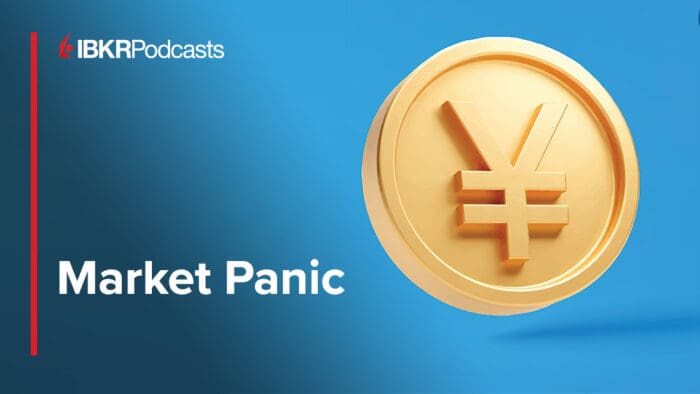Following the powerful rise of the Japanese yen and the shortfall in US payroll growth, the IBKR Podcast team dissects the global stock market’s panic sell-off in search of capitulation.
Summary – IBKR Podcasts Ep. 180
The following is a summary of a live audio recording and may contain errors in spelling or grammar. Although IBKR has edited for clarity no material changes have been made.
Andrew Wilkinson
Hello, everybody. Welcome to today’s episode. This is Andrew Wilkinson with Interactive Brokers. Hope you’re doing okay. A crazy start to the week. We have two major events unfolding. The first was the slowdown in the labor market announced at the end of last week, where payrolls in the U.S. massively missed forecasts in July.
But the more important thing is the growing turmoil in the global stock market. So, let’s start with Steve Sosnick, Interactive Brokers’ chief strategist. Steve, were we ripe for a correction, or is the labor market more the straw that broke the camel’s back, do you think?
Steve Sosnick
Good morning, Andrew. I think we were ripe for a correction. We came a long way in a very short period of time. Bear in mind that as we’re taping this on Monday morning, August 5th, we’ve really only given back what we gained in SPX from the end of May on. So, this is very much still just a bit of a give back of a vertical move that we had from the end of May through the middle of June which at the time I called stock market Jenga because we were going ever higher while eating away at the foundation.
But I do think the proximate cause was actually… the jobs numbers aided and abetted the decline. But I actually really think the Bank of Japan is the main — I don’t want to say culprit — but unwinding of the yen carry trade to me is much bigger.
I’ve published this graph a couple times. We’re basically tracking the appreciation in the yen from about 161. Now it’s, roughly 143 or so. But NASDAQ, with the exception of last Wednesday — that weird head-fake up day at the end of the month, which I think was driven by end of the month factors — aside from that, they’ve moved largely in lockstep. And then of course the Nikkei itself getting hit.
It became all too easy for people to borrow yen. It wasn’t yielding anything. So, you didn’t really owe any interest costs and it had the nice little feature of continuing to depreciate all the time. So in fact, you were making money on both sides of the trade. If you were either buying Nikkei or you were buying momentum stocks, whether it was NASDAQ or somewhere else. That was already starting to unwind, and then it came crashing to a halt after the BOJ meeting. The U.S. didn’t really pay attention to that so much, because we had our own factors after the Fed or actually in advance of the Fed.
But since then, I think that’s been the main thing, because the character of this selling has very much of a “get me out” tone. And I don’t know if that “get me out” is risk managers tapping institutional traders and portfolio managers on the back or margin clerks, who are the streets most relentless sellers, tapping people on the shoulder. But basically, there’s a very strong “get me out” sentiment. And while, when you saw VIX open this morning above 50, there was definitely a real panic element to it.
Andrew Wilkinson
Steve, where is the biggest impact likely to be felt as a result of the unwinding of the carry trade? We saw the Japanese stock market, the Nikkei 225, down about 12.5 percent just overnight over the weekend. Would it be felt more in the U. S. than Japan?
Steve Sosnick
No, I mean, Japan was clearly the obvious trade because that’s a good local trade too. I mean if you’re a Japanese investor borrowing on margin you’re borrowing Japanese yen to buy the Nikkei, and as the yen weakens the Nikkei tends to rally because it’s an export based economy. And that worked until it ground to a real screeching halt, although that too actually was starting to fade before the BOJ meeting.
But it is felt globally because the problem is it’s been a global momentum trade led by the Mag 7. And particularly in the last few weeks, it’s been a strictly a momentum led advance. And over the weekend, we also got some very unhelpful news, where I will argue, the investing GOAT, the Simone Biles, times 12 of investing, Warren Buffett, basically said, “oh yeah, all you people have been just buying Apple , bidding it up, even as it’s transitioning from a growth stock to a value stock. I’m largely out. I’m 50 percent out and I have $277 billion in cash that I’d rather have earning T-bills.”
By the way, parenthetically, he may actually own more T-bills than the Fed does. But he, but you know, he basically saying, “I’m just leaving my money in T-bills right now”, is not a good sign for the markets, at least from a longer-term valuation point of view when you’ve got Buffett… It’s not even what he’s saying, it’s what he’s doing.
And it’s always better to watch what someone does than what they say.
Andrew Wilkinson
Let’s turn back to the labor market report. José, am I right in thinking that the biggest disappointment last Friday was a jump in the U.S. stock market to 4.3% in the unemployment rate? How did you interpret the nonfarm payrolls data?
José Torres
Absolutely, that downside miss on payrolls was huge. And then that increase in the unemployment rate really pointed to the accelerating feature that joblessness has, right? And once we are roughly 90 bp above the cycle’s trough, it’s hard to contain that uptick in unemployment. Against that backdrop, anecdotal evidence suggests that white collar folks are having a lot of difficulty replacing their jobs.
And a lot of the jobs that we are adding, and we’ve been saying this on these podcasts for a while, have had a non-cyclical tilt. You’ve had private education, healthcare, and government add most of the jobs, and then you had a long list of sectors with job losses. Against that backdrop, you also have initial claims making yearly highs, and continuing claims roughly at three-year highs.
So, against the backdrop of investor sentiment beginning this hour, business confidence definitely dwindling at this point, when you look at what’s going on with the capital markets it’s tough to see the labor market improve from here. I think the best chance is for the Fed to continue to well, to start lowering rates and to begin its easing cycle, and hopefully payroll gains don’t drop below 75,000 or 60,000.
That may very well happen by January or February, but the idea is to miss that so that we can sort of hit a trough in the cycle, not fall into recession, and then begin to expand slowly again.
But the odds of that are honestly low, and we’re seeing that in the markets with what Steve said volatility extremely elevated. Investors don’t think that companies are going to be able to make the numbers in the next six or twelve months against the backdrop of a deteriorating labor market.
Steve Sosnick
This morning, my former professor made big waves on CNBC, Jeremy Siegel, saying we need a 50 to 75 basis point cut in rates now immediately. That seems a bit panicky, and it seems a bit market oriented rather than economic oriented. My take is that actually would show the Fed panicking. José, what’s your view on something like that?
José Torres
Well Steve, we’re still not at 2% targets all around the world. Not saying that we need to be there to begin cutting rates, right – ‘cause we are quite restrictive as far as the federal funds rate is concerned. But look at what happened today at 10 a.m. By the way, stocks are off their lows. ISM services came in well above expectations.
Prices paid came in, I want to say 57, above expectations and accelerated from the previous month. So, we still have an inflation problem. And I don’t think when you look at the terminal rate somewhere close to the mid threes, the Fed doesn’t have that much space to cut like they did in the past.
Also reducing rates by that much so fast, I think that’ll give the wrong signal to the market and to corporates across the country And it may lead to even more panic. So I wouldn’t do that at this juncture. You gotta wait. Let’s see what Retail Sales shows. Let’s see what CPI shows. And go from there.
Andrew Wilkinson
Steve, I was going to ask you am I wrong in thinking that the Fed last week would have had access to the payroll number before they made the decision?
Steve Sosnick
We don’t know. José, do you know? I don’t know how early they get these numbers. I think they get some stuff 24 hours in advance, some stuff 48 hours in advance, but I have to plead ignorance on that one. I don’t know.
I don’t think Powell alluded to having the numbers in advance either before, certainly not during his press conference, and I don’t think he said anything, or any of the Fed governors have said anything since.
José Torres
No, I totally agree, and the meeting did end on the 31st. The numbers came out on the 2nd. I feel like that would be way too much of a lag for them to have the numbers at the point. And then, to your point, Steve, if he would have saw that report, he probably would have alluded to it. And let’s remember, ladies and gentlemen, it’s one report.
The next report might be 180. Unemployment rate might go down to 4.1 percent and then we’re talking about inflation again, right? So we got to be careful. Let’s see what the upcoming data prints show. And let’s go from there. This morning’s ISM Services was fine. And with ISM, a final point here, you have the competing S&P Global, used to be IHS market PMIs, and you can sort of look at both to see if they’re telling a similar story, right?
Sometimes they’re bifurcated, but in this case, it shows that the service sector, at least last month in July, did pretty well.
Andrew Wilkinson
Steve, you think it’s a case of buckle up the safety belt and let’s not panic on this?
Steve Sosnick
I mean, I think this morning was a bit of, I’m going to say panicky selling, forced selling. Gut you know, it’s funny because I, been like the text group with my college friends and they’re all like, “tell me when to buy.” So I think the buy the dip mentality still remains very strong.
I’ve been advocating for much, that people should be, not chasing momentum. And that they should be thinking a bit more defensively. And if you want to be invested think about value stocks, particularly specifically value stocks that pay a sufficient dividend, which by the way, all those dividends just got a lot more attractive as the 2-years fell from 4.5% to 3.75%, basically.
And that’s a more defensive posture. And neither has been winning, but value has been outperforming growth. I think if, again, take your cue from Warren Buffett to some extent, if he’s telling you this, if he’s doing this if he’s taking money aggressively out of what I think is a value stock that’s been priced like a growth stock.
And I’ve been saying that and I, to some extent, I feel vindicated because if Buffet’s doing, he’s not doing what I’m saying. But if his actions correspond with what I’ve been thinking, I think that’s the way to go. I think that just, momentum has this nasty way of flipping.
And just because the momentum worked for you on the upside for a while doesn’t mean that the momentum can’t drag you lower for some bit of time. And that’s to me, my biggest caution here: is don’t be too hasty. If you miss the dip, don’t worry about it.
I think now is more the time to be playing defense rather than offense. Another thing I want to bring up always is: if it’s difficult to price relatively risk free assets, the 2-year note being, you know, essentially very low risk, if not actually pure low risk. When you’re seeing 75 basis point moves in a week in a safe asset, how do you expect to price risky assets effectively?
And by the way, for those of you on 2-10 inversion watch, we actually disinverted for like a hot minute this morning and then fell back down. Yes. I actually happened to catch it. I put it out on Twitter actually. I happened to be looking at the graph as it happened. Now again, there, that’s like the Sahm rule. It’s one of these statistical rules that’s not really a rule. It’s low occurrence. Something that’s backed up by history, but there’s not necessarily enough occurrences over a given time frame to be statistically significant to really call it a rule.
But the rule about the 2-10 inversion is it tends to proceed recessions,and that the recessions tend to begin after the curve disinverts. So that’s another thing to keep an eye on because, again, the market is then pricing in aggressive cuts in the short term, which can be self-fulfilling toward a recession.
José Torres
And If I may add to that real quick, Andrew, before you ask that question, there’s reason to believe that the long end this time around, even if we go into a slowdown, is going to stay quite elevated. Two drivers to blame. One is the shift from globalization to regionalization, things being more expensive on the trade front, i.e. Mexico becoming our top importer here in the U.S. versus China. And then sovereigns running deficit financings, right? A lot of spending, a lot of issuance, high debt levels, I think that’s going to support a higher 10-year yield. So even if the Fed reduces the short end quite a bit, I think the 10-year is going to stay in the mid-3’s or higher.
Andrew Wilkinson
That’s going to catch up with us at some point. José, September the 17th, 18th is the next opportunity that the Federal Reserve has to cut interest rates, but do you see any particular number or series of numbers or event that could possibly make them ease between meetings? That’s a very unusual occurrence, but do you see anything that might happen?
José Torres
Definitely not on the numbers front. I think what could occur is something happening with banking. Regional depository institutions, commercial real estate, international banking firms, tied to Europe, tied to Japan, tied to China. Something along that front that has something more systemic, a more systemic feature, I think that’ll get you an inter-meeting cut.
But as far as data? I mean, we get the jobs report maybe two weeks before the next decision. So, I don’t think another bad jobs report would make them reduce rates right there when they have a meeting 10 days later.
Andrew Wilkinson
Right. Steve, final word from you. Does it feel like capitulation today or not?
Steve Sosnick
This morning was clearly some dose of capitulation between the yen getting clobbered and the VIX spiking and that was definitely a bout of forced selling. The question is forced by whom or why? We could spend another 40 minutes on that.
But yeah, it does feel like there was a bit of capitulation, but just because you have the short-term capitulation doesn’t mean that the move is done. It just means that, for that day or for that moment in time you’ve kind of paused.
I hate to sound like a Fed governor and say let’s watch and wait a little bit about the market, but I do think that’s it.
And the one thing that really gnaws at me is the fact that the Japanese banks got shredded. Like Mitsubishi down like 20%. So we are not necessarily seeing a banking crisis here, but certainly the Japanese investors are quite fearful that there might be something there. Who lent all these yen that might be having trouble getting paid back?
So, let’s see how this shakes out because I don’t think it’s just one of these that, okay, we’re done. Japan went down 20% in three days and it’s not a rule either, but the few times it’s done that have usually not ended well for global investors. So, Let’s take a deep breath here.
José Torres
We gotta see who has all these exposures, in this new era of leverage finance, across nations, across continents. Like in 2008, everyone was kind of scanning over every financial institution to find out who had the toxic mortgages, right? Maybe we would get to some kind of event like that in the next few weeks or so.
Hopefully not, but when you have Japan raising rates and then you have slowing economic conditions and restrictive policy in the U.S., there could be some systemic problem.
Steve Sosnick
I was on a call. I was on basically a post-Fed call with a network in Dubai. So I’d drop in the link, except it’s in Arabic. And so I don’t, I can’t understand exactly, but it was myself and a pretty prominent U.S. economist who I’ll leave out because I, this is not the best story for him.
And he’s been a very bullish guy, and he was there to talk about the economics after the Fed. This was between the Fed statement and the press conference. And I was talking about what the market was or was not doing, each kind of staying in our lane to some extent. And his comment, they kept trying to goad him into are we seeing a recession? Are we looking to recession?
And he said, you don’t really see the recession until or unless there’s a financial accident. And I don’t know the guy well enough to reach out to him and say, does this count as the financial accident? But I’m kind of thinking if it’s not a financial accident, we’re about as close as we can get.
So, that’s the part that kind of makes me a bit nervous.
Andrew Wilkinson
Steve Sosnick, Interactive Brokers Chief Strategist and Senior Economist José Torres, thank you very much for joining me
Steve Sosnick
Thanks guys. Take care.
José Torres
My pleasure, thanks.
Andrew Wilkinson
And remember to rate our recent podcasts wherever you download them from and look out for more at IBKR Podcasts.
Join The Conversation
If you have a general question, it may already be covered in our FAQs. If you have an account-specific question or concern, please reach out to Client Services.
Leave a Reply
Disclosure: Interactive Brokers
The analysis in this material is provided for information only and is not and should not be construed as an offer to sell or the solicitation of an offer to buy any security. To the extent that this material discusses general market activity, industry or sector trends or other broad-based economic or political conditions, it should not be construed as research or investment advice. To the extent that it includes references to specific securities, commodities, currencies, or other instruments, those references do not constitute a recommendation by IBKR to buy, sell or hold such investments. This material does not and is not intended to take into account the particular financial conditions, investment objectives or requirements of individual customers. Before acting on this material, you should consider whether it is suitable for your particular circumstances and, as necessary, seek professional advice.
The views and opinions expressed herein are those of the author and do not necessarily reflect the views of Interactive Brokers, its affiliates, or its employees.
Disclosure: Forex
There is a substantial risk of loss in foreign exchange trading. The settlement date of foreign exchange trades can vary due to time zone differences and bank holidays. When trading across foreign exchange markets, this may necessitate borrowing funds to settle foreign exchange trades. The interest rate on borrowed funds must be considered when computing the cost of trades across multiple markets.



















This is certainly a long-winded conversation. I thought the placing of the market drop on the Japanese and the yen trade was off base. This conversation didn’t get serious till they spoke about Buffett. As far as I am concerned it was buffett’s actions that spooked the market. When he dumped his big holdings Apple and Bank of America, which is a real long-term holding, made the market think he knew something they didn’t know. The question in my mind is did he learn something from Cook when he call cook. What did cook tell him? was this appropriate for off the record comments between cook and Buffett, apples largest shareholder.?W Revealed that the rest of the shar Would the SEC like to know what was said?